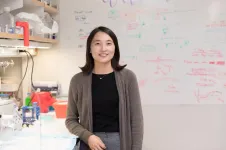(Press-News.org) A new collaborative study from researchers at the Geisel School of Medicine at Dartmouth and the University of Washington (UW) and published in the Proceedings of the National Academy of Sciences (PNAS), reveals unexpected insights into how skin exposure to ultraviolet (UV) light can worsen clinical symptoms in autoimmune diseases such as lupus.
Lupus, an autoimmune disease that can cause inflammation of the joints, skin, kidneys, blood cells, brain, heart and lungs, is caused when the immune system attacks its own tissue.
Previous research has established that in up to 80 percent of lupus patients, sunlight exposure can trigger both local skin inflammation and systemic flares, including kidney disease. But little has been understood about the underlying mechanisms that drive this process.
To define how UV light triggers kidney inflammation, the research team investigated the role of neutrophils--a type of white blood cell abundantly found in the body that acts as a first responder to any kind of inflammation and has been linked to skin and kidney tissue injury in lupus patients.
In the study, the researchers looked for markers of inflammation and injury in the skin, the blood, and the kidney at different time points following UV light exposure in mice. They were able to demonstrate that neutrophils not only infiltrated the UV light-exposed skin, but also dispersed throughout the circulatory system and migrated to the kidney.
"Interestingly, one subset of these neutrophils, the ones that we think are more damaging, first went to the skin that was exposed to the UV light and then turned around and went to the kidney," says Sladjana Skopelja-Gardner, PhD, an assistant professor of medicine at Geisel who worked with Keith Elkon, MD, at UW on the study. "That's a bit unusual--we normally think of neutrophils as short-lived cells that sort of zoom to where the inflammation is and then die off there."
The investigators found that a single exposure of skin to UV light stimulates inflammatory and injury processes in the kidney, including transient proteinuria, even in normal, healthy mice.
"To be clear, normal, healthy mice don't get the clinical type of kidney disease that you see in lupus patients," explains Skopelja-Gardner. "They get what we call subclinical injury, meaning there is an inflammatory and injury process happening in the kidney that is not visible by pathology or looking at the tissue itself. The mice recover and are fine afterwards.
"However," she adds, "this subclinical injury may lead to pathologic consequences in the vulnerable setting of pre-existing inflammation in lupus patients, and lead to kidney disease flare after exposure to sunlight."
Importantly, the inflammatory and injury markers they detected in the mouse kidneys following UV light exposure were very similar to the renal injury markers that are associated with more severe kidney damage in lupus patients. In addition, the exposure to UV light also triggered an immune response that is often expressed in most lupus patients--the type 1 interferon response--in both the skin and kidney.
"Overall, I think what our research demonstrates is that skin exposure to UV light can be the source of inflammatory pathways that are relevant to lupus, and that neutrophils play an important role as a pathogenic mediator in this process, contributing to kidney damage," says Skopelja-Gardner.
INFORMATION:
Founded in 1797, the Geisel School of Medicine at Dartmouth strives to improve the lives of the communities it serves through excellence in learning, discovery, and healing. The Geisel School of Medicine is renowned for its leadership in medical education, healthcare policy and delivery science, biomedical research, global health, and in creating innovations that improve lives worldwide. As one of America's leading medical schools, Dartmouth's Geisel School of Medicine is committed to training new generations of diverse leaders who will help solve our most vexing challenges in healthcare.
Doctors may be able to predict their patients' risks of fatal coronary heart disease more accurately by taking into account the number of adverse social factors affecting them, according to a new study led by researchers at Weill Cornell Medicine and NewYork-Presbyterian.
The researchers, whose findings appear Dec. 3 in Circulation, analyzed data from the Reasons for Geographic and Racial Differences in Stroke (REGARDS) Study that tracked cardiovascular-related health outcomes in more than 20,000 people for a decade. The new analysis showed that participants who had more adverse social determinants ...
The SARS-CoV-2 virus may enter and replicate in human cells by exploiting newly-identified sequences within cell receptors, according to work from two teams of scientists. The findings from both groups paint a more complete portrait of the various cellular processes that SARS-CoV-2 targets to not only enter cells, but to then multiply and spread. The results also hint that the sequences could potentially serve as targets for new therapies for patients with COVID-19, although validation in cells and animal models is needed. Scientists know that SARS-CoV-2 binds the ACE2 receptor on the surface of human cells, after which it enters the cell through a process known as endocytosis. Research has suggested that the virus may hijack or interfere with other processes such as cellular housekeeping ...
Chimeric Antigen Receptor T-cell therapy--CAR T--has revolutionized leukemia treatment. Unfortunately, the therapy has not been effective for treating solid tumors including childhood cancers such as neuroblastoma. Preclinical studies using certain CAR T against neuroblastoma revealed toxic effects. Now, a group of scientists at Children's Hospital Los Angeles have developed a modified version of CAR T that shows promise in targeting neuroblastoma, spares healthy brain tissue and more effectively kills cancer cells. Their study was published today in END ...
Astronomers at the Center for Astrophysics | Harvard & Smithsonian have detected the first Jupiter-like planet without clouds or haze in its observable atmosphere. The END ...
Friends are more than just trusted confidantes, say Michigan State University researchers who have examined the cultural and health benefits of close human relationships in a new study.
"Friendships are one of the untapped resources people can draw on to pursue a happier and healthier life. They literally cost nothing and have health and well-being benefits," said William Chopik, an assistant professor of psychology at MSU and the study's senior author.
Published in Frontiers of Psychology, the study is the largest of its kind and included 323,200 participants from 99 countries. Prior studies compared only a few specific cultures to one another -- but ...
The year 2021 marks the 100th anniversary of a fundamental discovery that's taught in every biochemistry textbook. In 1921, German physician Otto Warburg observed that cancer cells harvest energy from glucose sugar in a strangely inefficient manner: rather than "burn" it using oxygen, cancer cells do what yeast do -- they ferment it. This oxygen-independent process occurs quickly, but leaves much of the energy in glucose untapped.
Various hypotheses to explain the Warburg effect have been proposed over the years, including the idea that cancer cells have defective ...
CHAPEL HILL, N.C. - Many organizations are looking at effective ways to communicate the importance of wearing a mask, especially as highly transmissible new strains of coronavirus threaten to cause a surge in infections.
Experts at the University of North Carolina at Chapel Hill suggest positive messages are critical to supporting the effort.
Their findings, described in a study published in December in the International Journal of Environmental Research and Public Health, give public health experts, leaders and communicators critical insight to craft messaging that could potentially increase mask usage during the pandemic.
"As science evolved during ...
Abnormally hyperactive areas in the brain may help better predict the onset of Alzheimer's disease, according to findings of a research team led by Université de Montreal psychology professor Sylvie Belleville, scientific Director of the Institut universitaire de gériatrie de Montréal research centre.
Hyperactivation could be an early biomarker of Alzheimer's disease, the researchers say in their study published today in Alzheimer's & Dementia: Diagnosis, Assessment & Disease Monitoring, co-authored by Belleville and Nick Corriveau-Lecavalier, a doctoral student she supervises.
Worried about their memory
In their research, ...
A new study of Type 2 diabetes (T2D) in Japanese populations has uncovered a previously uncharacterized genetic variant that puts male carriers at greater risk for the disease, as well as the mechanism by which it does so. The impact of the variant was most pronounced in sedentary men; those with the variant had a 65% greater rate of T2D than sedentary men without it.
Researchers from the University of Southern California, along with colleagues in Japan, led by Professor Noriyuki Fuku of Juntendo University, found higher rates of harmful belly fat and T2D among Japanese men with a specific mitochondrial gene variant. This variant, in the site of the mitochondrial peptide ...
Researchers from LSTM's Centre for Snakebite Research and Interventions (CSRI) have led an international team investigating the evolutionary origins of a novel defensive trait by snakes - venom spitting - and demonstrated that defensive selection pressures can influence venom composition in snakes in a repeatable manner.
In a paper published in the journal Science, the team, which includes authors from the UK, USA, Australia, the Netherlands, Spain, Norway, Brazil and Costa Rica, provide the first example of snake venom evolution being demonstrated to be associated with a role in defence, ...


